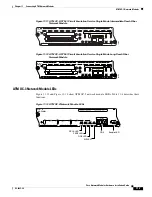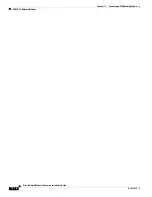
11-16
Cisco Network Modules Hardware Installation Guide
OL-2485-20
Chapter 11 Connecting ATM Network Modules
ATM OC-3 Network Modules
Estimating the Power Margin
The following example calculates a multimode power margin based on these values:
•
Power budget 10 dB (SONET worst-case specification for multimode fiber)
•
Link length 3 km
•
Four connectors
•
Three splices
•
Higher-order loss (HOL)
•
Clock recovery
The power margin is:
PM = PB – LL
= 10 dB – [3 km x (1.0 dB/km) + 4 x (0.5 dB) + 3 x (0.5 dB) + 0.5 dB + 1 dB] = 2 dB
The positive result means this link should have enough power for transmission. The product of
bandwidth and distance is 155 MHz x 3 km = 465 MHz-km; this is within the dispersion limit of
500 MHz-km.
Single-Mode Transmission
Single-mode transmission is useful for longer distances, because there is a single transmission path
within the fiber and modal dispersion does not occur.
The maximum receive power for SML is –10 dBm, and the maximum transmit power is 0 dBm. The
SML receiver can be overloaded when using short lengths of fiber. Overloading the receiver does not
damage it, but can cause unreliable operation. To prevent overloading an SML receiver, insert a
minimum 10-dB attenuator on the link between any SML transmitter and the receiver.
The SMI receiver cannot be overloaded by the SMI transmitter and does not require a minimum fiber
cable length or loss.
Table 11-10 Link Loss Causes and Amounts
Cause
Amount of Loss
Fiber attenuation
SM: 0.5 dB/km
MM: 1 dB/km
Splice
0.5 dB
Connector
0.5 dB
Modal and chromatic dispersion Depends on fiber and wavelength
1
1.
Dispersion is usually negligible for single-mode fiber. For multimode fiber, the product of bandwidth and distance should be
less than 500 MHz-km.
Higher-order mode losses
0.5 dB
Clock recovery
1 dB






























